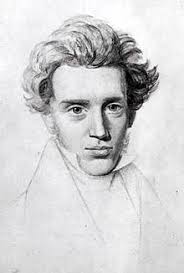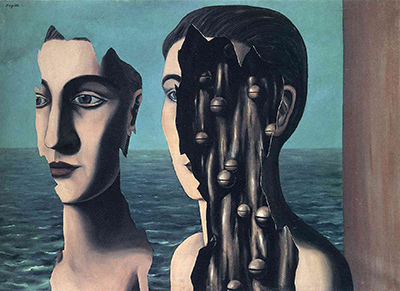61. Kierkegaard’s Problem and Solution, Part 1
Soren Kierkegaard
In this introduction to Soren Kierkegaard’s (1813-1855) philosophy I want to do three things: (1) make it clear what Kierkegaard’s fundamental problem is; (2) make it clear what his solution to the problem is; and (3) discuss the three ways of living Kierkegaard thinks are available to us and which one contributes best to his solution (for Kierkegaard’s bio go here). We will see that the fundamental problem is the widespread disintegration of selfhood; the solution is to become a self that is as integrated as possible through passionate action; and the religious life as realized in Christianity is superior to the aesthetic and the ethical lives when it comes to the development of integrated selfhood. In this blog, part 1 of 3, I will discuss what I take his fundamental problem to be, namely, the disintegration of selfhood.
The following entry from Kierkegaard’s journal gives us direct insight into his fundamental problem: “I have just returned from a party of which I was the life and soul; wit poured from my lips, everyone laughed and admired me—but I went away—and the dash should be as long as the earth’s orbit———————and wanted to shoot myself.”[1] Kierkegaard is having an existential crisis or a crisis that goes to the very heart of his existence. Thus his philosophy starts with a suicidal thought rather than some philosophical puzzle that can be safely analyzed at a distance. What exactly is this thought? I think it is this:
The experience of being one way on the outside and a radically different way on the inside; the experience, we can say, of being inauthentic.
This seems to be Kierkegaard’s fundamental problem: how can we avoid living a life where we constantly pretend? How can we avoid an inauthentic and dishonest life where are constantly lying to others? How can we avoid a life where what we say and what we do are out of synch? In The Concept of Anxiety (1844), Kierkegaard describes this state of affairs by “recalling a game in which two persons are concealed under one cloak as if there were only one person, and one speaks and the other gesticulates arbitrarily without any relation to what is said”.[2] Life, all too often, is a game in which our bodily gestures don’t accurately reflect what we think or feel. This widespread disintegration of selfhood is what sickens Kierkegaard since it adversely affects a wide variety of human relationships. In The Present Age (1846), he writes: “As it is the relationships still exist but they lack the force which makes it possible for them to draw together in inwardness and unite in harmony. The relationship expresses its presence and absence simultaneously, though not completely but rather as though it were drawled out, half-awake and uninterruptedly.”[3] To be sure, relationships still exist. But these sleepy relationships hover between absence and presence in a state of “exhausted tension” almost without meaning: “The same applies to a state of exhausted tension: the relationship continues; something is expressed with an abstract continuity which prevents any real break, but although it must nevertheless be described as an expression of the relationship, the relationship is not only ambiguously expressed, it is almost meaningless.” (PA, 46) He describes the state of a self out of synch with another helpful metaphor:
“Perhaps I can explain what I mean by a very simple illustration? I once knew a family who owned a grandfather clock whose works for some reason or other had got out of order. But the fault did not result in the spring suddenly unwinding or in the hand ceasing to strike; on the contrary, it went on striking in a curiously abstract, although confusing, way. It did not strike twelve times at twelve o’clock and once at one o’clock, but struck once all through the day at regular intervals. It went on striking all day long but never gave a definite time.” (PA, 46)
Many people “strike” throughout the day—they speak and act at regular intervals in their pursuit of various tasks—but their strikes have no real meaningful connection to the world. People act married and go through meaningless motions of marriage. People act like parents and continue to go through meaningless motions of parenthood. In many cases, it is not that the parents go away or the marriage ends. Rather, everything proceeds as usual but with no definite, integrated relation to the world. More importantly, there is no integration within the self as time goes by. The present is not an occasion to integrate the past and use it as a condition for a choice regarding the future. Rather, the present is an occasion to deny such integration and stay, as far as possible, in the now. It is an occasion to deny having a history rather than developing a history. When this occurs we get a sense that people are moving in accordance with some monotonous, suspended, meaningless inner time—the regular intervals of the broken clock—that doesn’t hook up with the historical time of the changing human experience. To be sure, someone may seem to be animated and connected on the outside. But like the two men under the sheet pretending to be one, we get a feeling that his outer gestures are masks not faces. In Concluding Unscientific Postscript (1846) Kierkegaard notes that we often avoid making eye contact with such a person for “fear of discovering that he does not have proper eyes but glass eyes and hair made from a floor mat, in short, that he is an artificial product”.[4] He continues: “If one happens to meet a mentally deranged person of this sort, whose illness is simply that he has no mind, one listens to him in cold horror. One does not know whether one dares to believe that it is a human being with whom one is speaking, or perhaps a “walking stick”….to get into a rational and speculative conversation with a walking stick—now that is almost enough to drive one crazy.” (CUP, 196)
Kierkegaard wants us to avoid this terrifying loss of humanity. In his book Either/Or (1844), Kierkegaard has his character Judge William speak the following passages to a young man, Johannes the seducer, who is in a state of extreme disintegration:
“Do you not know that there comes a midnight hour when every one has to throw off his mask? Do you believe that life will always let itself be mocked? Do you think you can slip away a little before midnight in order to avoid this? Or are you not terrified by it? I have seen men in real life who so long deceived others that at last their true nature could not reveal itself; I have seen men who played hide and seek so long that at last madness through them obtruded disgustingly upon others, their secret thoughts, which hitherto they had proudly concealed. Or can you think of anything more frightful than that you thus would have lost the inmost and holiest thing of all in a man, the unifying power of personality? Truly, you should not jest with that which is not only serious but dreadful.”[5]
If we agree with the Judge then we should not take the uncanny horrors of disintegration lightly. Rather, we should try to find a solution to the problem of inauthenticity and seek a unifying personality. But how? See part two for more…
Rene Magritte, The Double Secret (1927)
[1] A Kierkegaard Anthology, ed. Robert Bretall (New York: Modern Library, 1946), p. 7.
[2] The Concept of Anxiety (Princeton: Princeton University Press, 1980), p. 118. Hereafter, CA/page number.
[3] The Present Age (New York: Harper and Row, 1962), p. 46. Hereafter, PA/page number.
[4] See Concluding Unscientific Postscript, vol. I (Princeton: Princeton University Press, 1992), p. 196. Hereafter, CUP/page number.
[5] Either/Or, vol. I (Princeton: Princeton University Press, 1971).

